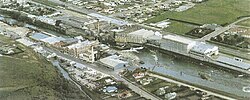Mataura River
| Mataura River | |
|---|---|
 This pulp and paper mill operated on the Mataura until 2000 | |
 | |
| Physical characteristics | |
| Source | |
| • location | Mountains to the south of Lake Wakatipu |
| Mouth | |
• location | Toetoes Bay |
• elevation | 0.0 metres (0 ft) |
| Length | 190 km (120 mi) |

The Mataura River is in the Southland Region of the South Island of New Zealand. It is 190 kilometres (120 mi) long.
Description
The river's headwaters are located in the Eyre Mountains to the south of Lake Wakatipu. From there it flows southeast towards Gore, where it turns southward. It then passes through the town of Mataura, and enters the Pacific Ocean at Toetoes Bay on the southern coast of the South Island. Much of its channel is braided.
The Mataura is renowned as a source of brown trout, and is a popular fishing venue. It has been identified as an Important Bird Area by BirdLife International because it supports breeding colonies of the endangered black-billed gull.[1]
History
The Mataura, along with the three other main Southland rivers, the Waiau, Oreti and Aparima, breached during the Southland floods of January 1984. Commercial and residential areas of the town of Mataura were particularly affected, including the pulp and paper plant. Until about 18,000 years ago the Mataura drained Lake Wakatipu. The Kingston Flyer follows part of the former river bed, now blocked by glacial moraine.[2]
References
- ^ "Mataura River". BirdLife data zone: Important Bird Areas. BirdLife International. 2012. Retrieved 2012-11-15.
- ^ Turnbull, I M (2000), Geology of the southeastern Eyre Mountains relevant to tenure review (PDF), Wellington, N.Z.: Department of Conservation, ISSN 1171-9834
46°34′S 168°43′E / 46.567°S 168.717°E
